Samsung Genelle Rodriguez-Otero Department of Business, American Public Military University MGMT 410 Fall 2024 Professor Tom November 3, 2024 Samsung
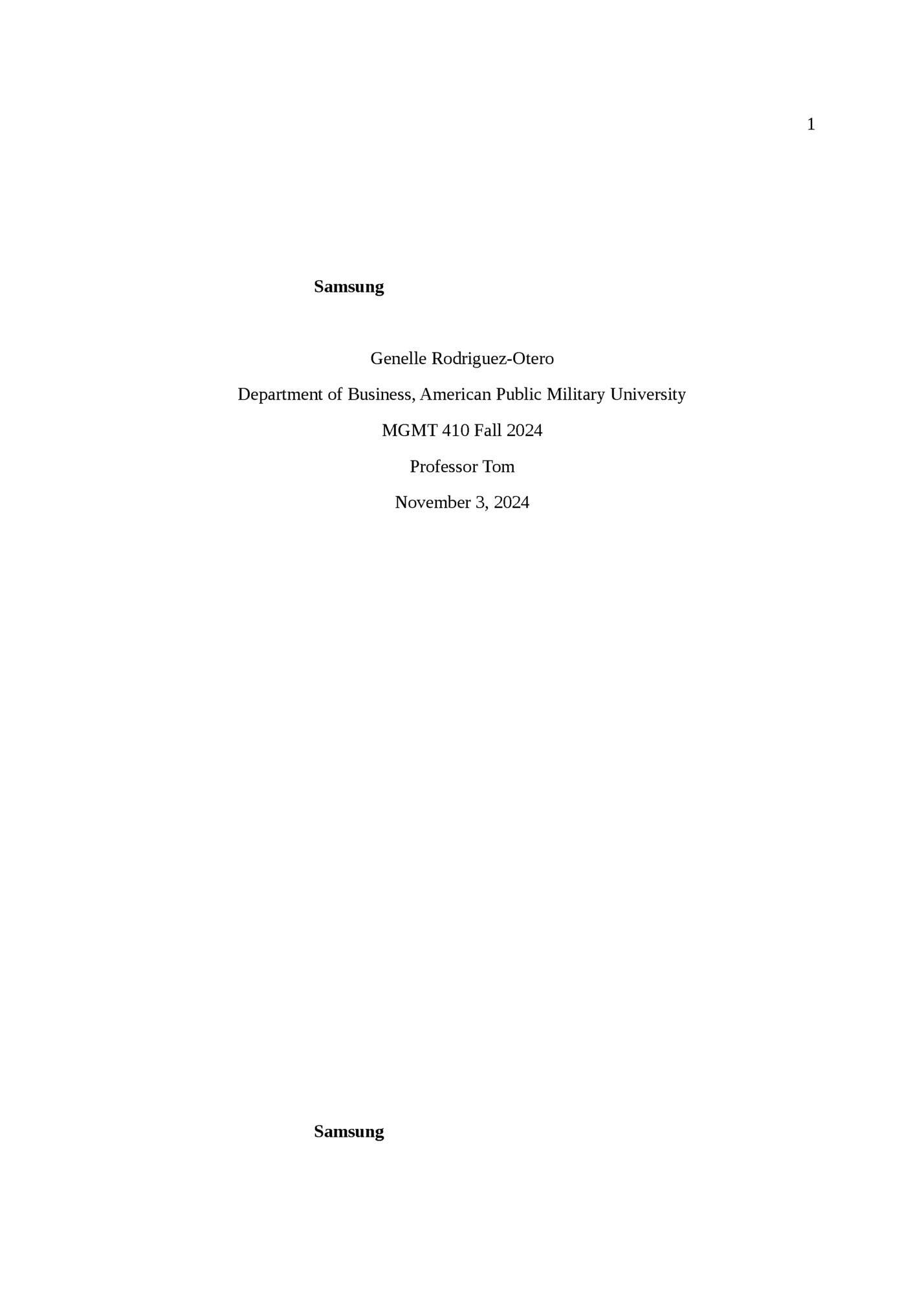
Samsung, a multinational company that has become the world’s largest manufacturer of electronic devices. From its beginnings as a grocery trading company in 1938 by Lee ByungChul in Taegu, Korea, the company now produces various technological devices that consist of cellphones to large appliances. In the last 30 years, the company has diversified its company portfolio into numerous business sectors, including construction and shipbuilding. Discussion on Samsung’s mission statement, lifecycle, Pestel framework, the Five Forces, TQM, and balance scorecard depicts how the company utilized various strategies and resources to their advantage in order to become one leading company in the tech industry. Mission Statement After dropping out of college, Samsung Founder Lee Byung-chul launched Samsung Trading Company in the late 1930s in which he was inspired by the Japanese company Mitsubishi which had a family-centric management structure. Yet, their mission statement was the driving force behind their sole purpose which influenced their business decisions, organizational strategies, and company operations. According to Zhou (2020), Byung-chul developed the mission statement “to devote its talent and technology to creating superior products and services that contribute to a better global society”. By investing enormously in research and development, Samsung was enabled to become one of the world’s largest companies in the tech industry due to their leading products (smartphones) and technological innovation (semiconductors). The mission statement held the company itself to a level of elevated expectations in creating superior products and quality which in return grew their customers and brand. Life Cycle
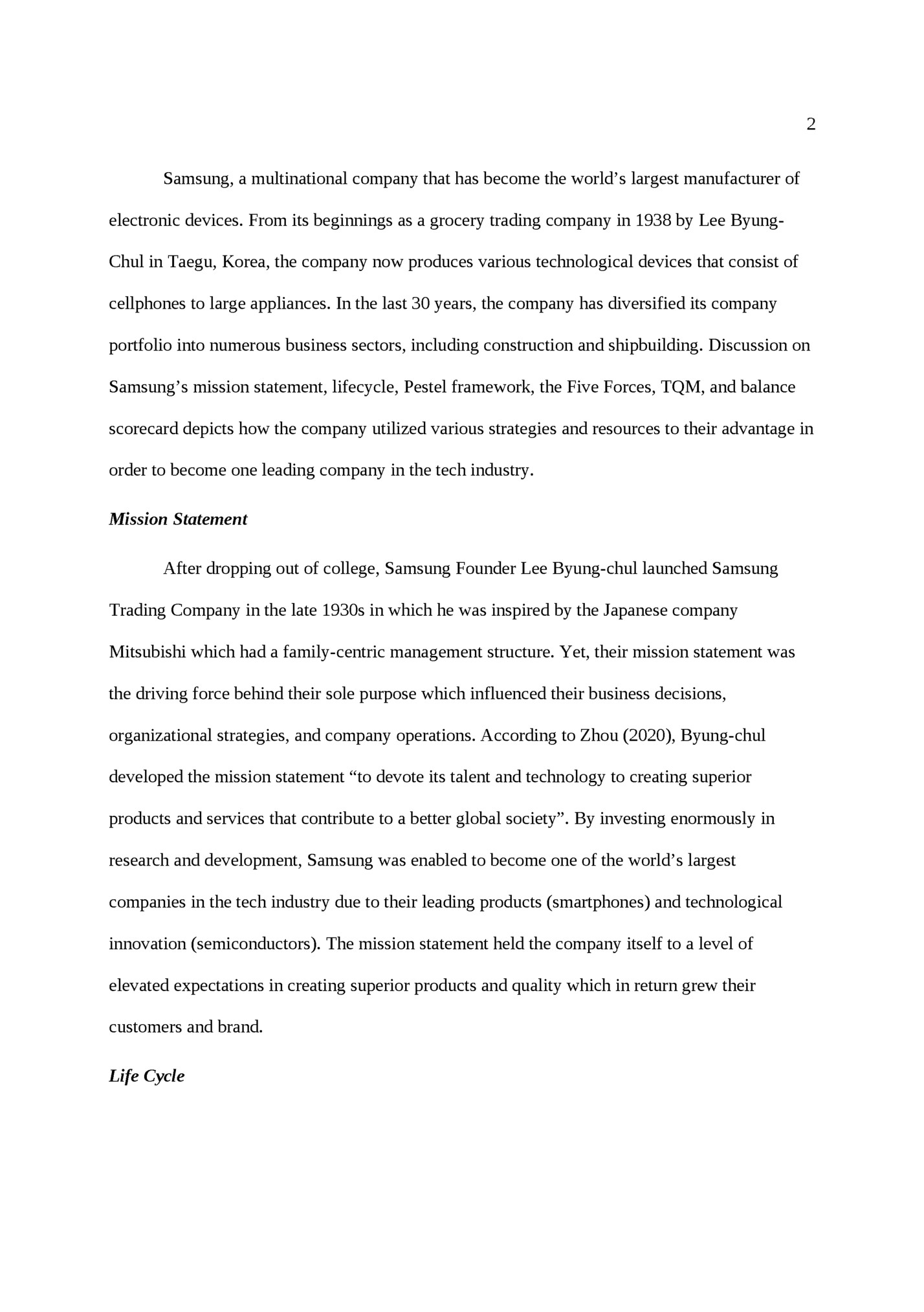
According to Cole et al. (2021), “large corporation failures and scandals have impacted corporate behavior on capital markets and society as a whole”. Failures in business have highlighted the need for businesses to be regulated by federal, state, and local governments including the enforcement. However, the success of a business is linked to the organization’s structure and framework. Samsung’s business lifecycle began in 1938 in which the business began from operating as a grocery trading company in Korea but began to launch new products such as smartphones and home appliances. New models that featured cutting-edge technology set the company apart from their competitors. In the growth stage, the company gained acceptance and brand loyalty by utilizing an extensive distribution network that could produce top-tier technological products with a wide range of availability. Additionally, the company continued to gain customer satisfaction, which built their clientele. Although the company grew vastly in the growth phase, the company began to reach their peak sales in volume in the maturity phase. As Apple company began to become popular due to the introduction of the iPhone and the cloud capabilities, the company sought to stay competitive by adjusting their pricing, offering promotions, and improvements in the products to maintain customer appeal towards their products. Eventually, the company entered the decline phase in 2021 due to a shift in customer preferences towards Apple products that resulted in a decline in sales. Pestel Framework Our current society and economy are directly affected by the constant change within our environment that businesses must adapt to change and be competitive to remain in business (Salem, 2018). The environment (internal and external environmental factors) has proven to be both an opportunity and a threat to any company on the market, regardless of the industry sector. Samsung has faced several challenges to remain competitive using the PESTEL framework to
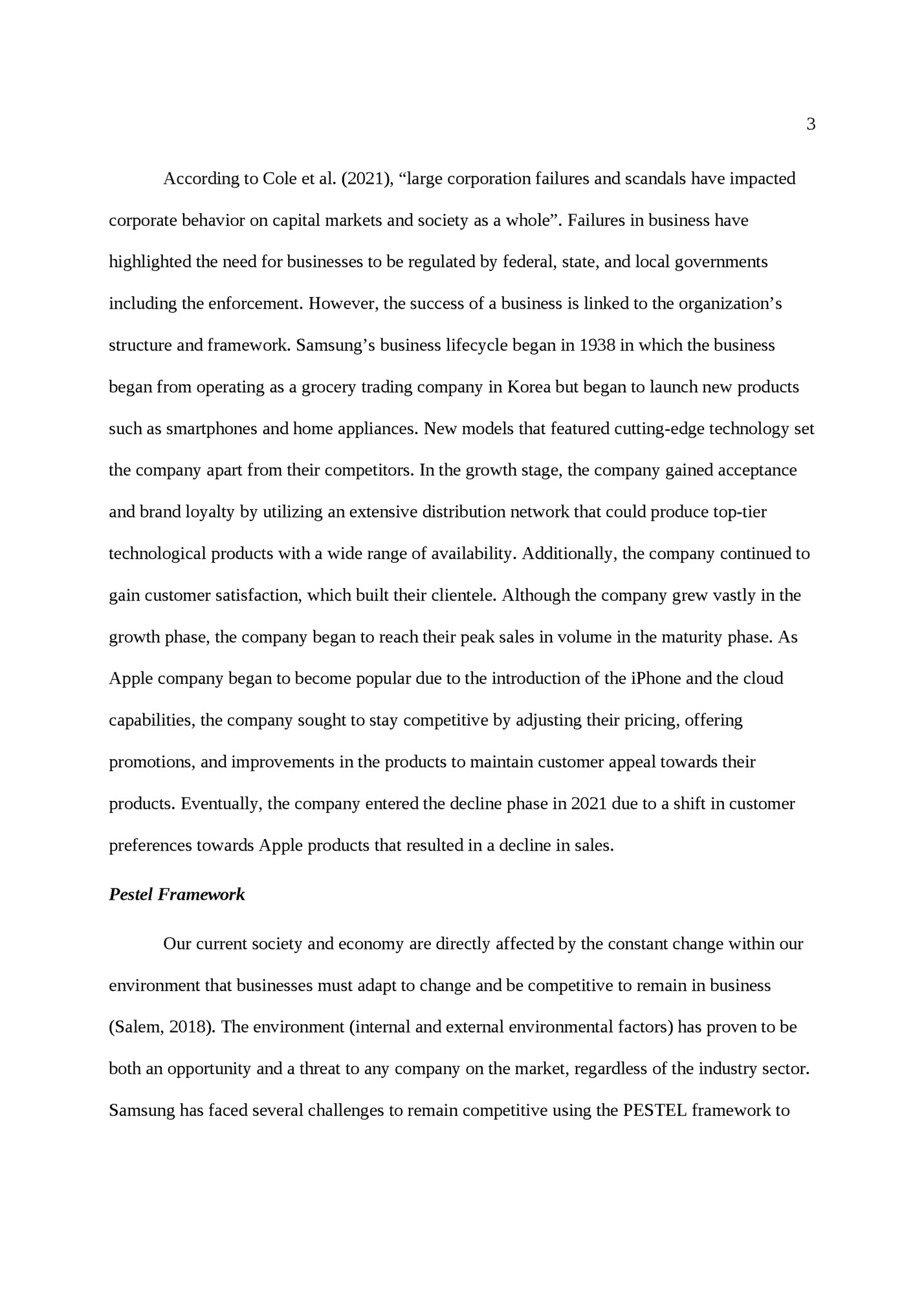
build and maintain their multinational company. The political factors that affect Samsung are the positive trade relations with South and North Korea which helps to lower their costs. Since Samsung is international, the business is at risk for regulatory changes due to political instability. Additionally, changes in government policies in their market such as the EU and US regarding labor laws and tariffs significantly impact their company’s revenue and operations. Environmental factors that have played a role in the downturn of Samsung business were the economic recession since the Covid-19 Pandemic in early 2020 and the current inflation which has decreased their consumers ability to purchase their products. Also, the company has experienced fluctuations in their currency due to the exchange rates in their key market areas decreasing, specifically the United States which decreased their yearly profits. The launch of the iPhone and the increase in popularity of the Apple product is a social factor that has contributed to the decline of the consumer preference which inadvertently affects their business due to Apple’s ability to gain preference with key demographics (teens, middle class) via social media. Their mission to stay innovative has been reflected in the technological factors of the Pestel framework by investing heavily in technological advances which has helped them remain competitive through innovation. By decreasing their carbon footprint and making changes to company policies regarding their supply chain and production facilities has enable them to make efficient use of their resources by eliminating waste and bringing awareness to environmental factors. Samsung must comply with legal factors such as international and local regulations that pertain to consumer data privacy, legal disputes (mismanagement of company funds), and labor laws and practices in various countries that produce their products. The Five Forces
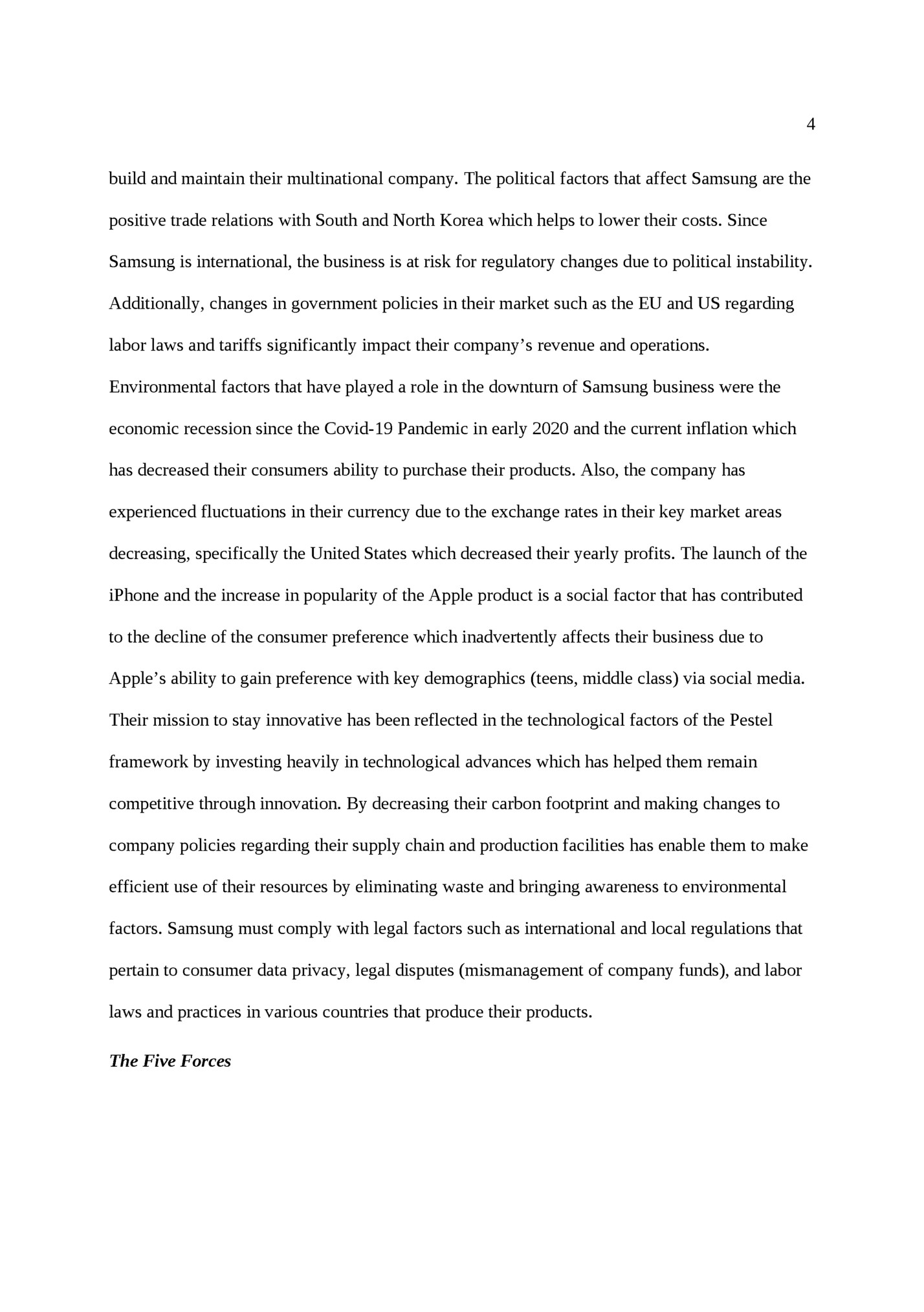
Businesses must develop a strategic framework that is based upon the Porter’s Five Forces Model which analyzes their competitive advantages within their industry to determine its profitability potential. Samsung has made it difficult for its competitors to enter the tech industry to its customer’s loyalty and placing patents that restrict other companies from creating a similar product to theirs which decreases the threat of new competitors. Samsung’s bargaining power of consumers is moderate because they have been able to keep their bargaining power high due to switching to low-cost devices (Team, 2024). In return, the loss of a single client will not have a significant impact on their business revenue. Also, Samsung’s bargaining power of their suppliers exerts a competitive advantage due to having few suppliers that offer their innovative produce which allows them to control their vendor pricing. The intensity of competitive rivalry is highly competitive for Samsung due to the growth rate of the tech industry and numerous competitors such as Apple whose products are in high demand. As a result, it increases their marketing costs and competitive pricing, which decreases annual profits. However, reanalyzing these threats consistently enhances their ability to strategize and maintain their competitive position in the tech industry. Total Quality Management Samsung's total quality management (TQM) is based on a variety of concepts and strategies that motivates the company to consistently improve quality and profitability simultaneously (Gupta, 2017). Samsung's TQM focuses on quality leadership, employee motivation, methodologies, preemptive priorities, and key field management activities. Based on the Japanese organizational behavior of doing of what is expected without question from their top leadership allows them to set high standards to meet company goals and expectations. Samsung invests considerably in their HR department to recruit top candidates and provide
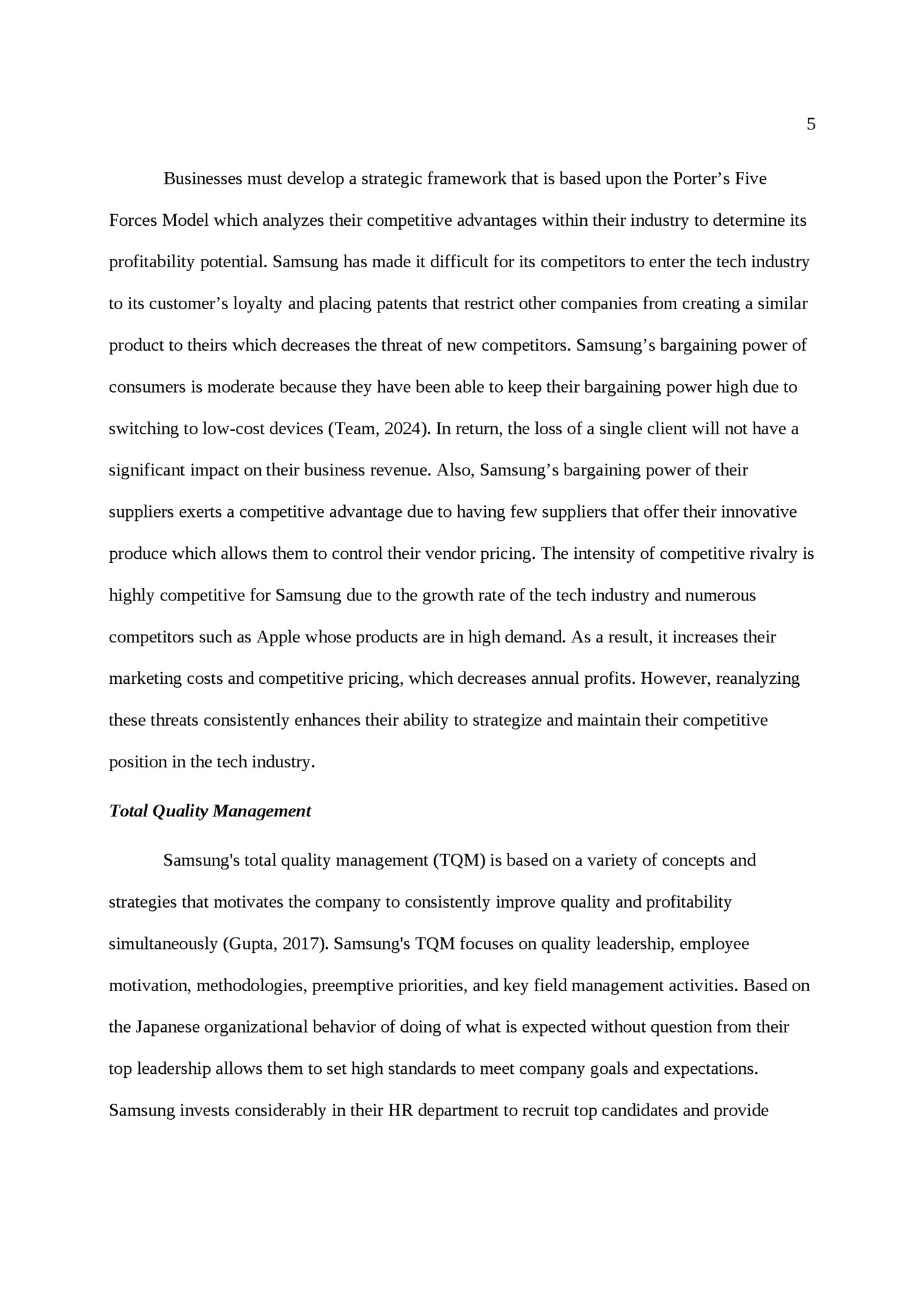
continuous training and development which motivates their employes to generate new and fresh ideas that create innovation. Samsung follows the Six Sigma methodology to analyze their procedures and products which allows for continuous improvement while being proactive by monitoring their product quality (ISO 9001 manufacturing quality standards) to ensure that deviation from their targeted goals and objectives are eliminated, remain consistent with product quality, and customer retention. Lastly, Samsung regularly sends out customer focus surveys to gather customer feedback to help improve their customer loyalty by meeting their demands for innovation and quality expectations. Balanced Scorecard Robert S. Kaplan and David P. Norton first proposed the Balanced Scorecard approach in 1992 as a fundamental way to measure the organization’s performance. Samsung invests in highmargin products and monitors their financial risk by analyzing fluctuations in their revenue and growth in their profit margins, including an accurate cost management system to ensure that they have a high ROI. Their customer focus surveys, and marketing campaigns help to attract and retain Samsung customers and boost their brand recognition. Throughout the years, Samsung has learned to improve their business prospective by continuing to improve their products while streamlining their supply chain management using the Six Sigma methodology. Fostering a positive work environment and developing employee competencies and skillset (employee development programs) directly impacts their organizational culture which allows them to adapt to internal and external environmental factors as well as customer expectations and needs. Conclusion Samsung’s commitment to their mission statement has allowed the company to create superior products and maintain its competitive edge within the industry. From its small

beginnings as a grocery trading company in Taegu, Korea, in 1938, the company has now expanded into a multinational corporation that has emerged as the world's largest manufacturer of electronic devices. Today, the company manufactures a wide range of technological devices, from cellphones to large appliances. Samsung's clear and concise mission statement has helped to prevent the decline of their lifecycle by identifying internal and external factors within the Pestel framework, strategizing against the Five Forces, and monitoring their TQM that determines their company’s performance through their balanced scorecard. Thus, Samsung consistently demonstrates how a company should use various strategies and resources to its advantage in order to become a leading company in the tech industry. References Cole, R., Johan, S., & Schweizer, D. (2021). Corporate failures: Declines, collapses, and scandals. Journal of Corporate Finance, 67, 101872. https://doi.org/10.1016/j.jcorpfin.2020.101872 Gupta, M. (2017, December 8). Samsung tqm [Slide show]. SlideShare. https://www.slideshare.net/slideshow/samsung-tqm/83621873
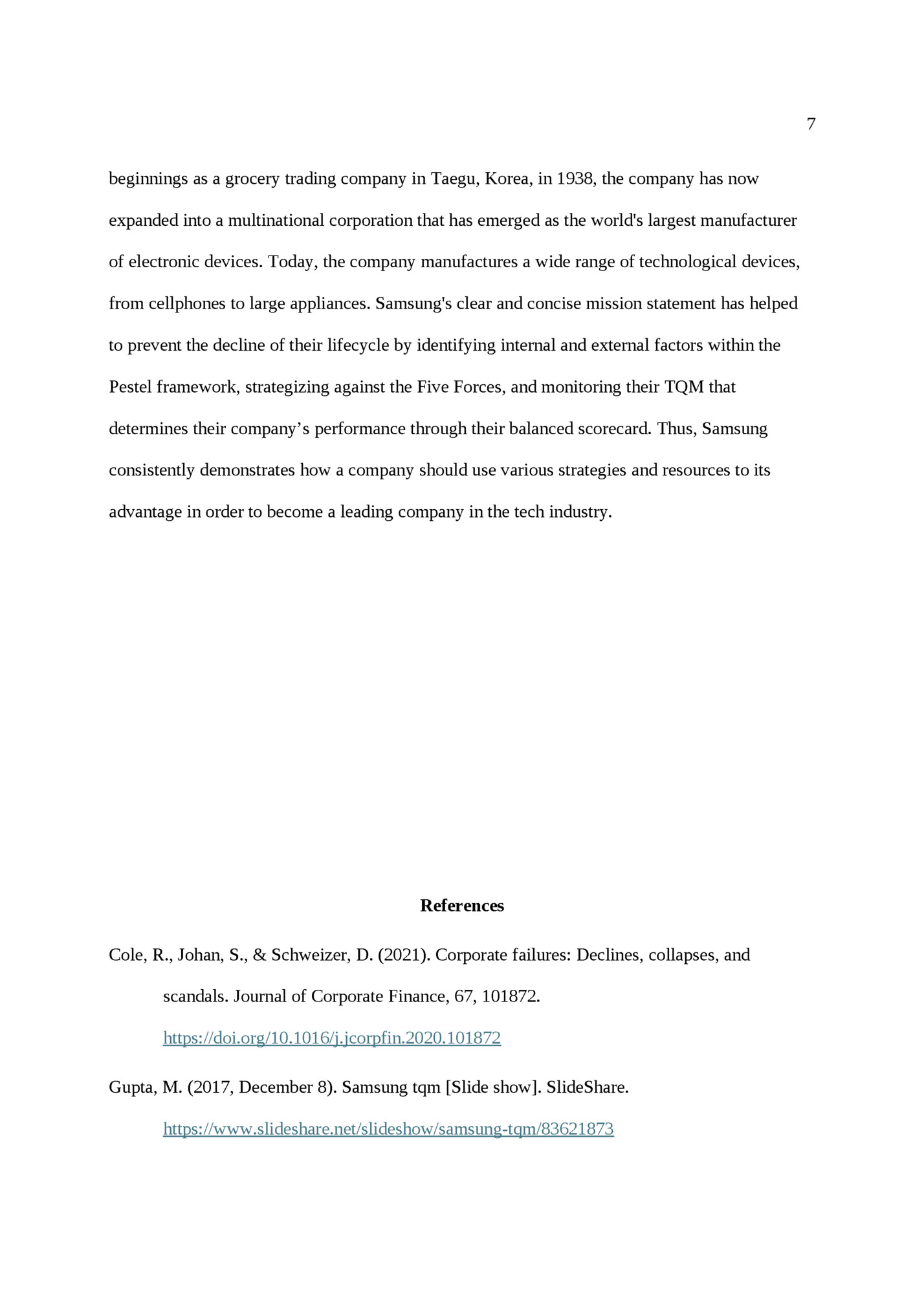
Salem, A. (2018). Pestel Analysis Introduction. University of Salford. https://www.researchgate.net/publication/327871826_Pestle_Analysis_Introduction Team, M. S. (2024, February 26). Samsung Porter Five Forces Analysis. MBA Skool. https://www.mbaskool.com/five-forces-analysis/companies/18268-samsung.html Zhou, Y. (2020). The Samsung story. Nature Electronics, 3(5), 234. https://doi.org/10.1038/s41928-020-0418-8
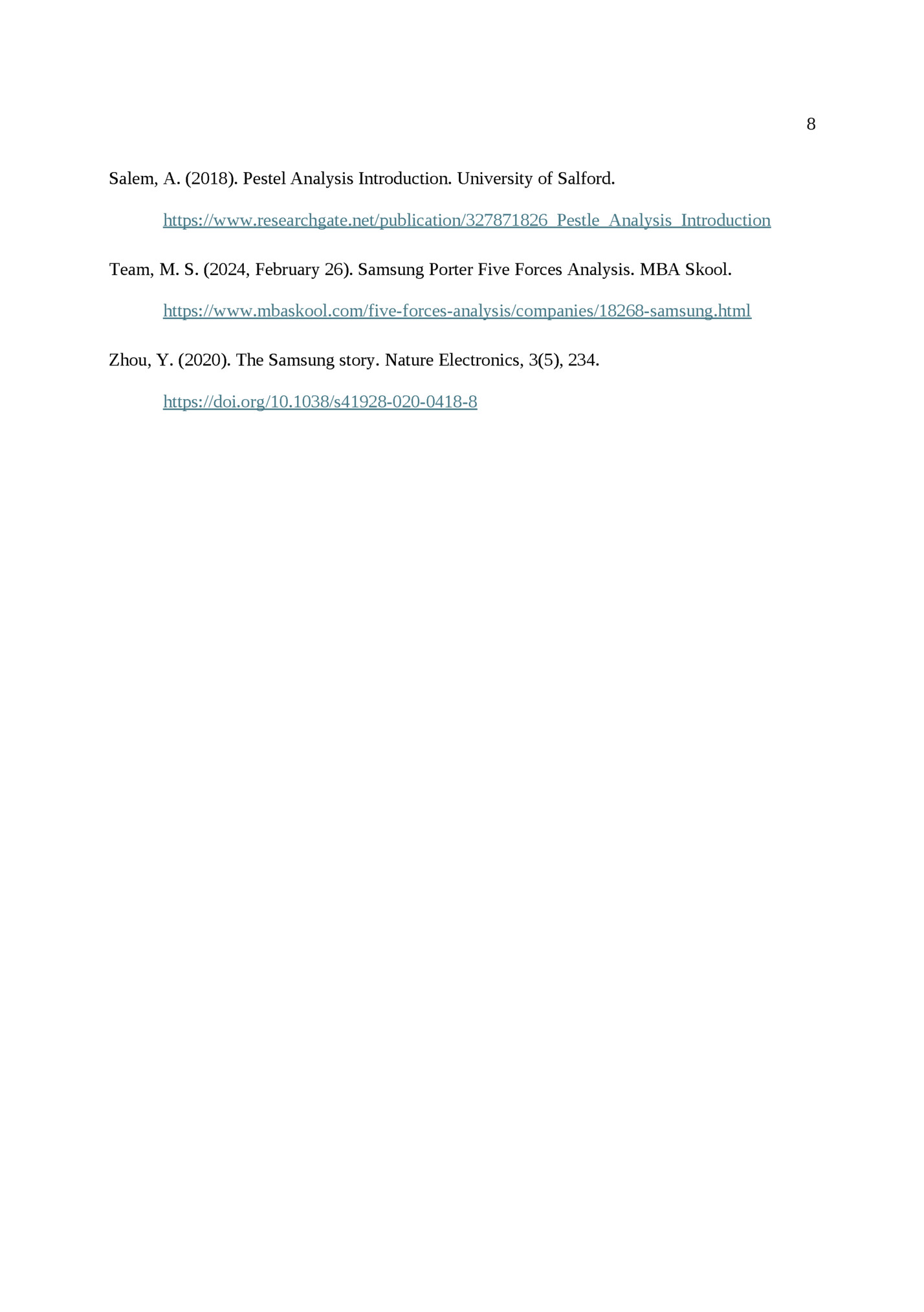
Fleepit Digital © 2021